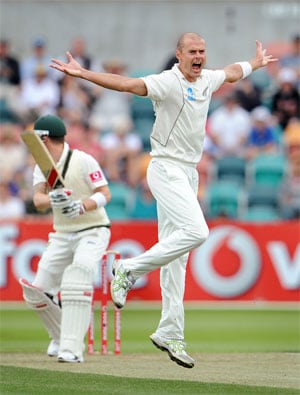New Zealand in unexpected command over Australia in 2nd Test
New Zealand find themselves in an unexpectedly commanding position following an eventful second day of the second Test, in which Australia's batsmen failed utterly to cope with a difficult though not unplayable Hobart pitch.
- Written by ESPNCricinfo Staff
- Updated: December 10, 2011 01:49 pm IST
 New Zealand find themselves in an unexpectedly commanding position following an eventful second day of the second Test, in which Australia's batsmen failed utterly to cope with a difficult though not unplayable Hobart pitch.
New Zealand find themselves in an unexpectedly commanding position following an eventful second day of the second Test, in which Australia's batsmen failed utterly to cope with a difficult though not unplayable Hobart pitch.
(Scorecard)
The visitors battled to 3 for 139 and a lead of 153 by the close, after their seam attack had rumbled Ausralia out for 136 in reply to what had been thought an inadequate 150. Ross Taylor and Kane Williamson played with fierce resolve and positive intent, though New Zealand's captain should have been out for 14 when he skewered Michael Hussey to gully. Phillip Hughes, enduring a most unfortunate match, could not hold on.
Hussey's slow medium accounted for Jesse Ryder via a superlative legside stumping by Brad Haddin, but it was the last of 12 wickets on day two as New Zealand reached a vantage point from which they can glimpse a first Test victory in Australia since 1985.
Led by Chris Martin's unstinting bounce, movement and accuracy, all the visitors' bowlers had moments to enjoy in the morning as Australia briefly stared at the possibility of being bowled out for less than 100 for the fourth time in 18 months, and the third in the space of a year. Peter Siddle and James Pattinson produced the most substantial partnership of the innings from the depths of 7 for 75, but could not prevent New Zealand from gaining an unexpected first innings lead of 14.
Usman Khawaja and Michael Clarke fought hardest among the batsmen, who were all found woefully deficient against the moving ball. Following Martin's example, Tim Southee, Trent Boult and Doug Bracewell each found a hint of deviation either way to exploit Australian vulnerability. Boult pouched three wickets on debut and impressed with his subtle swing and sustained line.
Resuming at 1 for 12, Khawaja and David Warner played and missed often amid pushing a few runs, and New Zealand were given the early impression they were well and truly in the contest. This notion was confirmed when Warner walked into a drive at Martin and edged succinctly to first slip.
Ricky Ponting walked to the middle in a Hobart Test for the first time since his double century against Pakistan in 2010, intent on another score of heft. One or two crisp connections suggested he was in good touch, but he was soon made to look as foolish by Southee as Graham Gooch used to be at the hands of Terry Alderman.
Expecting Southee's stock outswinger, Ponting shaped to leave, but realised too late that the ball was whirring in at middle stump. A panicked swipe of the bat across his front pad was far too late to avoid an lbw so plumb the Ponting was walking well in advance of the umpire Nigel Llong's raised finger.
Khawaja had fought the kind of vigil endured by Brendon McCullum on day one, his bat probing at thin air as often as it struck the ball. Eventually the accumulation of pressure told, Martin extracting the edge he had long threatened to find to dismiss Khawaja for the first single figure score of his young Test career.
Michaels Hussey and Clarke had been Australia's most reliable duo in recent Tests, and for 23 runs they offered promise of a resurgence. But Daniel Vettori's hamstring strain had afforded the visitors a fourth seamer, and Boult responded to Hussey's commanding pull stroke by having the batsman pouched behind when trying to leave the next ball.
Not one for obstinate defence, Haddin drove impulsively to wide mid-off, another stroke he will wish to forget following the ugly smear against South Africa in Cape Town. Clarke's resistance, by far the most prolonged and effective of any member of the top six, was ended when he allowed a Bracewell delivery to pluck out off stump - redemption for the bowler after a similar dismissal of Clarke in Brisbane was overruled by a no-ball.
Siddle and Pattinson had taken the new ball together on day one, but they would not have expected to be accompanying each other to lunch on the second, still a long way short of New Zealand's humble tally. Through a combination of shrewd shots and straighter bats than many of the full-time batsmen had managed, they added 56.
Eventually Siddle let his guard down and edged Bracewell to third slip. Pattinson immediately flashed at Boult and fell victim to a sharp snaffle by Williamson in the gully, before Starc was lbw on referral to the third umpire Aleem Dar.
Neither Pattinson nor Siddle bowled well in the 10 overs to tea, and Clarke swung them to opposite ends on resumption with immediate effect. For the third time in as many innings Pattinson found a corking delivery to touch McCullum's outside edge, and next over Martin Guptill admonished himself fiercely for flirting at Siddle when he could have left well alone.
Ryder did not suggest permanence at any stage but reached 16 before he wandered out of his crease in trying to flick Hussey away, and Haddin capitalised. Ryder exchanged words with Ponting before his departure, but Australia's fire would be doused by Taylor and Williamson.
Taylor has endured a difficult time on this tour, and he played in a self-denying manner reminiscent of Dean Brownlie to build a stand. Williamson showed a sound back-foot game and a greater range of strokes than he had managed in three fretful innings previously.
